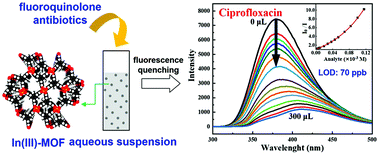Two isomeric In(iii)-MOFs: unexpected stability difference and selective fluorescence detection of fluoroquinolone antibiotics in water†
Abstract
The detection of antibiotics in environmental water or food is of great importance for protecting human health. New facile methods and high-performance sensory materials for the detection of antibiotics are highly desirable. Herein, we present two isomeric In(III)-MOFs, BUT-172 and BUT-173, which have slightly different three-dimensional (3D) open framework structures consisting of 1D infinite secondary building units (SBUs) and bridging tritopic carboxylate ligands. Both of the MOFs show a high porosity, and their micropore volumes and BET surface areas were estimated to be 0.66 and 0.67 cm3 g−1, and 1357 and 1366 m2 g−1, respectively. Stability tests revealed a high stability of the two MOFs in liquid water at room temperature. BUT-172 even retained its structural integrity in aqueous solutions with the pH values ranging from 3 to 10 at room temperature, and in boiling water for 24 hours. Unexpectedly, BUT-173 was gradually degraded under the same conditions, although the two MOFs are isomeric and have similar 1D infinite SBUs. The stability difference is believed to be related to the different structural symmetries of the two MOFs. In addition, the fluorescence of the two MOFs (suspension in water) can be efficiently and selectively quenched by many fluoroquinolone antibiotics, including ciprofloxacin, one of the most widely used antibiotics worldwide. The limits of detection for sensing the fluoroquinolone antibiotics reach nearly 50 ppb. In contrast, many antibiotics of other types, and even the quinolone antibiotics without a fluorine atom did not show such a strong quenching effect on the fluorescence of the MOFs. The fluorescence detection performance towards the fluoroquinolone antibiotics was not obviously interfered with by various substances (including metal ions, acid, base, and some antibiotics other than fluoroquinolones) that co-existed in the analysis system, and the MOF sample after a detection test could be regenerated for repeated use without an apparent loss of function. The experimental results suggested that the MOFs may serve as potentially useful sensory materials for the detection of a class of important antibiotics, and this work also demonstrates that highly hydrolytically stable In(III)-MOFs could be constructed and used for some meaningful applications in water.



 Please wait while we load your content...
Please wait while we load your content...